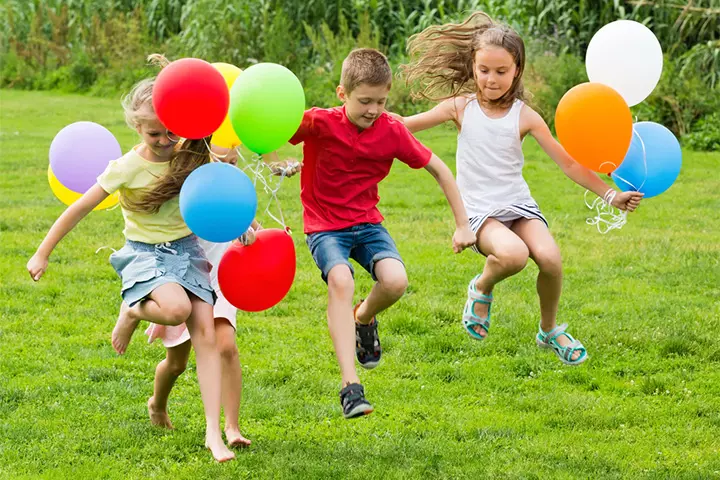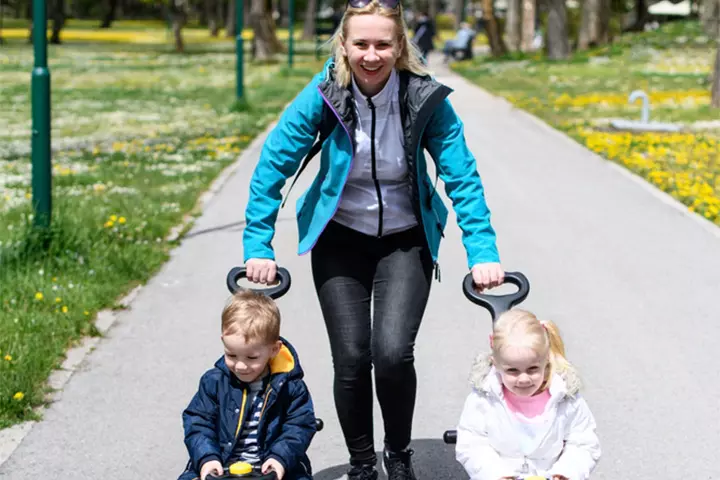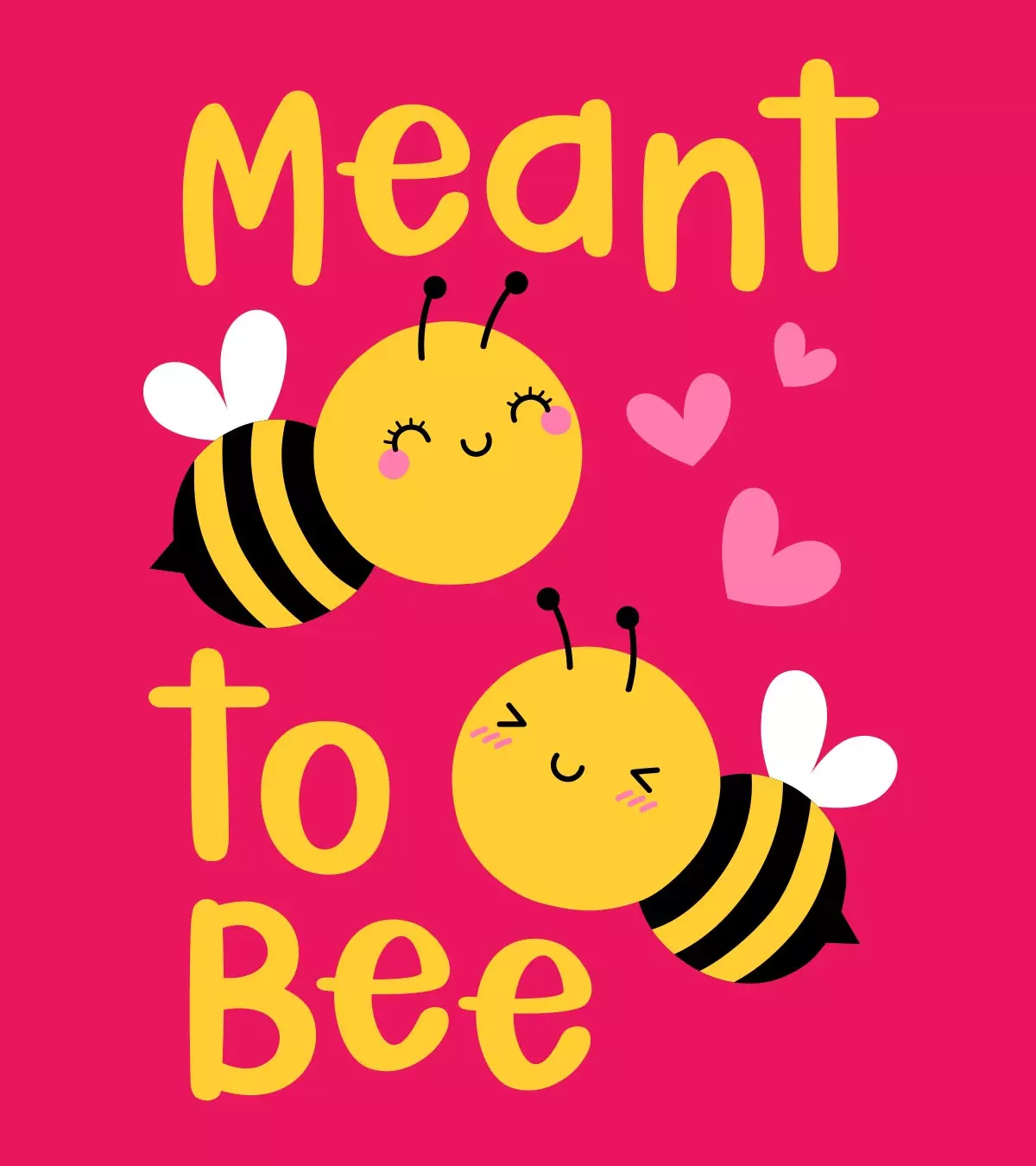
Image: Midjourney/ MomJunction Design Team
Siblings share the best relationships. And for that relationship to form, there have to be common grounds of interaction wherein they can learn about many things. This post on games to play with siblings helps them be engaged with each other. While doing so, they can learn some important lessons about communication, teamwork, and the value of having healthy competition. Also, these games will allow them to know about each other and give them a chance to spend some quality time and make memories.
Regardless of the type of game, playing with siblings fosters joy and laughter, creating bonds that can last a lifetime. Rachel, a blogger, shares how video games strengthened her relationship with her brother. She says, “I’d like to think that the reason why my brother and I are so close is because we bonded so much in our early years through playing video games together. He and I are really close in age as well (19 months apart), so we were always each other’s playmates no matter what. Video games allowed us to solve problems together (i).”

Key Pointers
- Games, such as the floor is lava or Simon says are ideal for a fun time and bonding with siblings.
- Go for a balloon toss that adds hours of laughter as each one will struggle to keep it in the air.
- Outdoor activities, such as the three-legged race, will bring you closer.
- Twister, potato drop, coin drop, and more fun games as you scroll through.
Playing With Siblings: Benefits For Kids
Playing with siblings is a great way for children to develop emotionally, socially, and mentally. Here are some ways sibling playtime helps them grow (1) (2) (3).
- Fosters creativity: Imaginative play and pretend play with siblings inspire kids to think creatively as they come up with stories, create rules, and explore new ideas together and, in turn, improve their problem-solving skills.
- Increases physical activity: Activities like hide-and-seek and backyard play help kids stay active while enjoying themselves. They often include energetic actions like running, jumping, and exploring, which help with physical development.
- Enhances social skills: Playing with siblings helps children develop critical social abilities, such as sharing, teamwork, and communication, and lay the foundation for healthier relationships beyond the family.
- Teaches sympathy: When siblings comfort each other during difficult moments or show kindness when playing, they learn to recognize and connect with each other, which helps build empathy.
- Improves conflict resolution: When siblings argue during play, it allows them to learn how to negotiate and make compromises. These moments help children get better at solving problems and handling conflicts in the future.
- Boosts language skills: Games that involve talking, such as explaining rules or telling stories, help kids improve their vocabulary and listening and speaking skills.
- Encourages healthy competition: Games teach kids to handle winning and losing. They motivate children to do their best, all while learning valuable lessons about being fair and respecting others.
- Strengthens emotional connections: Playing together helps children create lasting memories and deepen emotional bonds.
111 Games To Play With Siblings
Siblings are each other’s biggest support but can also be notorious and bicker over the slightest of things. These sibling games will make sure they get along with each other and not get bored.
Cooperative Games To Play With Siblings
1. The floor is lava
This is the perfect indoor game for kids. Arrange your furniture at strategic places around your living room and throw some pillows and yoga mats on the floor. Your children have to go from one end of the room to the other without stepping on the floor. They can step on the pillows, mats, etc. If you have some wooden planks, your children can use them to make bridges too.
2. Sibling art
Place a large canvas or spread butcher paper on a wall or the grass. Divide the canvas or paper into sections for each child. Give them crayons, watercolors, or acrylic colors, and let them create art. This activity allows them to plan their art according to the space available. You could encourage them to cooperate with each other and make art that overlaps several sections.
 Quick tip
Quick tip3. Sibling craft
Children love making something from scratch. So, give them some empty cartons, kid-friendly scissors, crayons, and tape, and let them loose. They can collaborate and create a craft, such as a cardboard house or a cardboard robot, or use the cartons as cars and race around the house. Whatever they make, it is sure to keep them engaged for a long time.
4. Animal doctor
Give your children a doctor’s playset and let them get all their toys to set up a veterinary clinic. They can give their “animals” a check-up and write prescriptions for their ailments. Ask your children to feed the “animals,” pretend to clean them, and play with them as they desire.
5. T-shirt walk
Put two children in one oversized t-shirt and ask them to walk around the house. You could even take this activity to the backyard as there is a lesser chance of them stumbling over something and getting hurt. The activity is beneficial for improving communication between your children.
6. Apple roll
Give your children an apple and tell them to roll it between their bodies without dropping it. The more children you have, the funnier the game. This is a great game to improve communication and collaboration between your children.
7. Dens
Do you remember making pillow forts in your childhood? They are the ultimate secret place for storing your possessions and spending time alone. Let your children make their own dens and hiding holes inside or outside the house. If you live in an apartment, they could put some chairs together, throw a bed sheet over them, and sit under them.
8. Ice scavenger hunt
Ice scavenger hunts are a great way to teach your children about colors. You can make ice cubes in various colors and shapes and scatter them throughout your garden. Give each child a list of ice cubes they have to find, such as a red star, blue heart, or big green ball. The child who returns with all the ice cubes on their list is the winner.
Although this game is typically played in the winters in snowy areas, you can make this a summer sport too, wherein your children have to race against time and find the ice cubes before they melt.
9. Balloon tennis
This is another balloon game for kids that they are bound to love. Inflate a balloon and use any flat item such as books or paper plates as paddles. Your children can play this game in the house without the fear of breaking something.
10. Roll the ball
Let two children hold a long piece of cardboard. Place a ball in the center, and they should try to keep the ball on the board for as long as possible. This game will make sure your children cooperate with each other, and there will also be frequent bursts of laughter.
11. Pillow sumo wrestling
On days when your children are cooped up inside the house, it is crucial for them to spend their energy so that they do not become cranky. Pillow sumo wrestling is a good way for them to release their energy while being safe. Put your child in your t-shirt, insert two pillows on the front and the back and use a belt or a rope to secure them. This way, punches will be absorbed, and they won’t get hurt even if they fall.
12. Ice melting
Science experiments with ice are a great way to get your children to play together. Freeze ice overnight in big containers. Give your children different ingredients such as sugar, salt, and vinegar. Let them experiment to find out which ingredient melts the ice faster.
13. Balloon kick
Here is another balloon game that your children will enjoy playing together. Inflate a balloon and toss it in the air. The only condition is that your children have to keep it airborne without touching it with their hands. They can use their legs, face, nose, tummy, etc.
14. Balloon toss

Inflate one balloon for each child or give them one balloon. They should toss it in the air and not let it fall to the ground. The game guarantees hours of laughter and bonding.
15. Puddle jumper
This is another indoor game, but you can play it outdoors too. Fill three plastic or paper cups with water. Put a ping pong ball in the first cup and then blow on it to transfer it to the next cup. This game will improve your children’s lung capacity. Make sure you have some paper towels handy for handling the water spills.
16. Freeze
Ask your children to dance to music. However, they have to freeze as soon as the music stops. If you see movement when the music goes off, the player is out. This game gives your children a chance to move their bodies and let go of energy. It can also help develop a love of dance.
17. Cheerio tower
To prevent fights and arguments at the breakfast table, ask your children to build a Cheerio tower. Lick the bottom of each Cheerio so that it sticks to the one below it. This will keep your children occupied for quite some time.
18. Balloon balance
Inflate a balloon and let two children balance the balloon between their hips. They should not touch it with their hands. Next, they have to walk to the end of the room without dropping the balloon. If they drop it, they have to start all over again.
19. Together we stand
Tell your children to sit on the floor with their backs touching and their arms linked at the elbows. They have to stand up without disturbing this arrangement. This will result in some pushing and shoving and lots of laughs.
20. Touch the pom-poms
Each player gets a pom-pom that they can attach to the back of their shirt with a clothespin. Then they have to run around and touch the pom-pom attached to the other players’ backs.
21. Alphabet scavenger hunt

This game is for children learning the letters of the alphabet or numbers. You can hide different plastic letters around your backyard or your home and ask your children to find them. Besides playing together, they will also learn letters and numbers. The first child who searches all the letters or numbers gets a cute prize.
22. Blindfolded treasure hunt
Hide some sweets around the house before blindfolding one of the siblings. With their eyes open, the other sibling becomes the guide, leading the blindfolded sibling to discover and enjoy the sweets using only spoken directions.
23. Recipe reveal
It is an entertaining cooking game for children. They can select a recipe, divide it into steps, and each secretly follows their own instructions. Then, they cook together, pooling their efforts. It’s an excellent way to develop partnership and cooking abilities while sharing a homemade meal.
24. Backyard camping
Backyard camping is an excellent opportunity for siblings to enjoy some outdoor fun in a safe setting. They can set up a tent in the backyard, pretend to toast marshmallows over a makeshift campfire, and even go stargazing. This activity promotes outside exploration, collaboration, and basic survival skills while remaining close to home.
25. Capture the flag
Another exciting two-player game for siblings is Capture the Flag. Each player establishes their zone with a hidden flag. The goal is to sneak into your opponent’s zone, seize their flag, and return it to your base without being tagged.
26. Three-legged race

Tie the left leg of one player and the right leg of another player together. The children have to walk with their legs tied to the finish line without falling over. If they fall, they have to start again. This is a great game to teach them collaboration.
27. Time capsule
Children can gather items that reflect their current lifestyles and interests for this activity. They may put these items in a container with a future opening date so they can remember them afterward, fostering nostalgia and sibling bonds.
28. DIY talent show
Everyone gets a chance to shine in this activity by sharing a talent or skill that they enjoy. Every child takes turns performing, whether singing, magic tricks, dancing, storytelling, or something completely original. You can set up a separate ‘stage’ where the performances can take place in your home.
29. Flour game
Fill a bowl with flour and seal it with a plate to mimic a cake for a fun sibling game. Then, flip the cake and remove the bowl carefully so that the shape of the cake doesn’t get disturbed. Place a piece of candy on top, and then have the siblings take turns gently carving thin slices of the flour ‘cake’ without causing it to fall. If someone causes it to fall, they are only allowed to use their mouths to take the candy out.
30. Build a castle
Begin by distributing the sand, tools, and buckets evenly among everyone. Then, set a fair time limit, such as 45 minutes to an hour. Invite everyone to make their own sandcastle, encouraging them to use their imaginations.
Competitive Games To Play With Siblings
31. Paper airplane race
Give your children sheets of paper or newspapers. Let them build paper planes and fly them to see which airplane goes furthest. You can also encourage your children to research new types of airplanes and come up with some cool designs.
32. Scavenger hunt
Let each child make a list of at least ten items they want their siblings to find. They can either hide these items themselves beforehand or make a generic list that includes things such as something tiny, something red, and something rough. The child who gets all the items on the list first is the winner.
Brendan Mahan, a father and ADHD coach, shares a heartwarming experience of creating a scavenger hunt for his twin boys that made them feel valued and loved. He explains, “I mentioned that my main motivation for this activity was to give the boys a fun memory. Closely related to that was a desire to help them remember past good times. The boys have been on a bit of a negative kick lately, and I wanted to remind them that we’ve done some pretty cool stuff just in our regular travels around town. To that end, I tied many of the clues to places we frequently have fun in, have been fun in the past, or are tied to our common travels. I revealed this about 1/2 of the way through the hunt, to help them solve one of the riddles. Suddenly our travels from one clue to the next became filled with their stories and recollections of the things we had done at the various places we had visited during the day. It made me feel really good to hear them talk about their memories of playing at playgrounds they had outgrown, the times we had gone out to breakfast with their grandparents and how much they enjoyed exploring and climbing on a big rock when we took walks at the local pond (ii).”
33. Simon Says
Simon Says is a classic game that is guaranteed to let your children play and enjoy each other’s company. You could be Simon, or let one of your children be Simon. You could even get your children to stop crying and throwing a tantrum with this game.
34. Follow the leader
If the older sibling is tired of being followed around by their younger brothers or sisters, you can ask them to play this game. In this game, the younger ones can assume the role of the leader, and the others follow their instructions. This will give your younger children a taste of responsibility as well.
35. Twister
“Twister” is an excellent game for rainy and snowy days when your children cannot go out to play. The rules are simple – you have to twist the spinner, and after it stops, you have to read the moves on the spinner and place your hands and feet on the twister mat accordingly. If you do not have the twister mat with you, you can draw colored circles on a big sheet of canvas or paper and make random cards to pick.
36. Ping pong bounce
This is an active game for indoor days. Punch two holes in a paper cup and thread a rope through them. Tie the cups around your children’s waists. Now put in some ping pong balls in the cups, and they should jump and twist their waists to get all the balls out. The first child to get all the balls out is the winner.
 Do remember
Do remember37. Pictionary
Pictionary is a fun drawing and guessing game for families with many children. One player takes on the role of artist, while the others attempt to guess what is being drawn. There is a time limit, and the artist can only utilize drawings to convey words or phrases. The winning team is the one with the highest score at the end of the game.
38. Obstacle race
Nothing makes a child happier than a well-organized obstacle race. You can execute various indoor and outdoor obstacle course ideas for kids using the things you find at home. Use cardboard boxes and sheets, chairs, and laundry baskets, and other items to make an obstacle race.
39. Ball drop
This is a game that requires concentration and precision. All you need is a ping pong ball, some plastic cups, and a chair. Your children have to stand on a chair and throw the ping pong ball into the plastic cup. After each round, you can move the cup a bit farther.
40. Pop the balloons
If your children love popping balloons and do not mind loud noises, you can let them play this game. Inflate some balloons and put them on the floor. The children have to sit on the balloons and pop them. On no account can they use their hands, legs, or other body parts to pop them. They can even press a balloon between two of them and pop it.
41. Popcorn mouth toss
If you have some popcorn at home, why not have some fun while eating it? In this game, two children stand a little distance apart and toss popcorn into each other’s mouths. After each successful toss, the player must take one step backward. If you are playing with your family, you can make teams of two players each.
42. Balloon leg pop
This is another form of balloon popping game that your children will love. This sibling game is best played with three or more children. First, you need to tie a balloon to the right leg of each player. Then, each player has to stomp on the balloons of the other players. The last player with a balloon on their leg is the winner.
43. Potato drop
This is a race for competitive siblings. Put bowls at the end of the room and give a potato to each child. They have to hold their potato between their knees and walk to the bowl and drop it in. They are not allowed to touch the potato at any point.
44. Coin drop
Here is another excellent game for improving children’s gross motor skills. Place some coins on a table. Your children have to pick the coins, place them on their faces, walk to another table, and deposit their coins in a bowl. They should not touch the coins while walking or dropping them in the bowl.
45. Popcorn cup catch
One player stands at one end of the room with a plastic cup, and another player stands at the other end of the room with 20 popcorns. The player with the popcorn starts throwing them one by one into the other player’s cup, and the other player tries to catch them by moving the cup. In the end, the player who manages to gather the maximum number of popcorns wins.
46. Popcorn distance throw
Play this game at home with some popcorn. Stick some painter’s tape on the floor to show the start line. Each player stands at the start line and throws popcorn as far as they can. The player who throws the popcorn farthest gets a big bowl of popcorn.
47. Bottle bowling
Bottle bowling is a fun indoor game that brings the excitement of a bowling alley into the comfort of your house. Arrange ten empty plastic bottles in a triangle shape at the end of a hallway to play. Bowl with a soft ball, such as a foam or plush toy. The goal is to clear as many pins as possible in a few rolls. You can keep score or just take pleasure in some fun competition.
48. Sack race
Siblings step into a huge sack or pillowcase, leaving both legs inside. They grip the top of the sack to keep it upright. When the game begins, everyone sprints as fast as they can towards a finish line, which is usually demarcated with a ribbon or cones. The catch is that they must keep their balance while they hop within the sack. It’s a race between siblings that is filled with laughter and friendly rivalry. The winner is the first player to cross the finishing line.
49. Water balloon fight
You may prepare yourselves for a spectacular water balloon fight in your backyard on a sunny day in the summer. All you need are some clever tactics and colorful water balloons to make the most of the school holidays.
50. Duck, duck, goose
One child walks around the circle, gently tapping each player’s head and saying ‘duck’ with each tap. When they decide, they will tap someone on the head and scream, ‘Goose.’ The ‘goose’ must get up and chase the tapper. The tapper becomes the goose if the goose tags them before they sit in the goose’s place. If not, the tapper stays. This game gets even better with cousins joining in the fun.
51. Hide and seek
Hide and seek is a traditional sibling game in which one person counts while the others hide. The seeker then attempts to locate the missing siblings. It’s a simple and enjoyable game that becomes much more enjoyable with more siblings involved.
52. Tag
You can select one player to be ‘it,’ while the others become runners. The player who is ‘it’ counts down from ten to start the game. If you’re the one who is ‘it,’ your goal is to chase and tag one of the other players by touching them with your hand. On the other hand, if you’re a runner, your objective is to evade being tagged. When a runner is tagged by the player who is ‘it,’ they switch roles, with the tagged runner becoming the new ‘it.’ It gets even more entertaining when more siblings join in on the fun.
53. LEGO challenge
Begin by gathering a variety of LEGO bricks and pieces. Then, you can take turns drawing challenge cards or picking from a list of challenges. These challenges can include building certain objects, such as a large structure or a one-of-a-kind spaceship, within a time limit. You can also compete to see who can construct the most innovative structure out of a limited number of bricks.
54. Chess
Chess is a classic strategic game that siblings will enjoy. The goal is to checkmate your opponent’s king, putting it in an impossible position to escape capture. Chess necessitates critical thinking, preparation, and planning. It’s a patience and strategy game with countless possibilities, making it a fun and intellectually stimulating game for siblings to compete in.
55. Rock, paper, and scissors
Rock, paper, scissors is a quick and enjoyable hand game for two people. Each player simultaneously creates one of three shapes with their hand: rock, paper, or scissors. Rock beats scissors, paper beats rock, and scissors beat paper. If both players select the same shape, the game is a tie, and they must play again. It’s a basic and quick game often played to make quick decisions or have fun with siblings.
56. Staring contest
The staring game is a test of focus and self-control. To play, two people sit face to face, maintaining eye contact without blinking or smiling. The primary objective is for the other person to first laugh, blink, or break eye contact. Players race against one another to determine who can outlast the other.
57. Ball and towel
Grab a beach towel and a ball. Have your children stand on opposite ends of the towel and take turns dropping the ball onto it, trying to keep it bouncing without touching the floor. It’s a fantastic activity to keep siblings entertained and occupied when looking for something fun.
58. Scrabble
Players make connecting words in a grid on the game board. Each letter is worth a certain number of points, and the goal is to form words that maximize your score. Players take turns horizontally or vertically building words and connecting them to existing words.
59. Race on ride-on

Children love riding on their ride-on cars at breakneck speeds. So give them a chance to compete with each other in your backyard or even your hallway. This game teaches balancing, improves observation skills, and helps develop a healthy competitive spirit.
60. 20 questions
It’s an entertaining guessing game for children. One person can think of something, it can be an object, a person, or a place, and their sibling has 20 yes or no questions to guess what it is.
61. Thumb wrestling
Thumb wrestling is a short and enjoyable activity that siblings can play together. Players face each other and intertwine their hands, leaving their thumbs free. The goal is to catch your sibling’s thumb while they try to catch yours.
62. Dance-off
Play some music and take turns showing off your dance moves. Each child has a chance to shine with their twirls, grooves, and distinct style. The other sibling can watch, judge, or participate in a dancing duel.
63. Karaoke
Set up a karaoke machine or utilize a karaoke app, select your favorite songs, and sing your heart out. The lyrics are shown on a screen, and you can even give each other points for your performances.
64. Baking challenge
Each child competes to make the best treats using a baking recipe that can be selected by them or you. You may set a time limit to add an intriguing twist. They can work alone or in groups. After baking, taste-testing and presentation judging comes into play. The best part is that you can enjoy the wonderful results of the baking challenge as a sweet reward.
65. Trivia
You might collect questions on a variety of themes like family, movies, and superheroes or play a trivia board game. Players can ask questions in turns, and the right answers gain points. Whoever manages to get the most points wins.
66. Mini golf at home
Set up a mini-golf course with household items such as cardboard tunnels, cups, and books as obstacles. Each sibling takes turns navigating the course, attempting to finish with as few strokes as possible. You may use a miniature golf club or improvise with a stick. Keep track of your score and go for a hole-in-one.
67. Origami challenge
Begin by gathering a colorful choice of origami paper and looking for instructions for a variety of origami designs. Each child chooses a design and attempts to fold it correctly under a time limit. You could also provide bonus points for successfully completing more intricate designs to increase the difficulty.
68. Suck it up
Fill one bowl with M&Ms or peanuts and give each child two bowls – one with M&Ms and the other empty. You can set a timer and then let the challenge begin. Players can transfer an M&M from the full bowl to the empty one using a straw. The person who moves the most M&Ms in the least time wins, making it an exciting competition.
69. Puzzle race
A puzzle race is an entertaining game in which children battle against the clock to complete a jigsaw puzzle. Each child begins with the same puzzle, and they compete to put it together as quickly as they can.
70. Lip sync battle
Siblings can have fun and get creative by performing lip-sync routines to their favorite songs in a lip-sync battle. They may choose a song, come up with a choreography, and then perform it while lip-syncing the lyrics. Even though they’re not singing for real, the trick is to put on the most entertaining and believable performance possible.
71. Mini-Olympics
Organize a variety of events such as obstacle courses, running races, and even indoor sports challenges for your children. Keep score by assigning points to each event. Siblings can compete in order to win. It’s a great way to participate in a variety of sports activities.
72. Doodle with noodle
In this game, children must use only their mouths and lips to construct an alphabet letter or number with the noodle. To make it more intriguing, you may consider setting a time limit. If your family is blessed with more children, you may make it a group exercise by having everyone do a short word instead of a single letter.
73. Ring toss
You can set up a row of bottles or pegs and give children plastic rings. Each child takes turns tossing these rings onto the pegs. Each successful throw is rewarded with a point. The child with the maximum score by the end of the game is declared the winner.
74. Ludo
Place the Ludo board around a flat surface. Each child chooses a color and arranges their game pieces in the starting area. Roll the dice and move your pieces on the board. If a six is rolled, the player is given another turn. The objective is to be the first person to move all of your pieces to the center of the board. The person who completes the task first wins.
75. Spoon and eggs
The spoon race is a fun sibling activity that gives normal racing a new spin. Each participant balances an egg in their mouth with a spoon. The goal is to race from the start to the finish line without dropping the egg. If an egg drops, the player must restart from the beginning.
76. Yank the cards
To play this fun game, first place a cup and add a card on top of it. Similarly, stack all the cups one over the other with cards in between them to make a pyramid or tower. Gather all the players around and ask them to take turns drawing the cards. In order to win, a person has to draw as many cards as possible without letting the tower tumble or collapse. The player who draws the most number of cards without disturbing the tower is declared the winner.
77. Jenga tower
Build a tower out of Jenga blocks, and have each child take turns removing one block at a time while attempting not to collapse the tower. The player who removes the most blocks successfully and prevents the tower from falling is the winner. It’s an exciting test of balance and precision that’s sure to spark competition between siblings and excitement.
78. Toothpick words
Distribute toothpicks to each player. The idea is to use only toothpicks to create as many three-letter words as possible. Keep in mind that they cannot be broken or bent. The game is won by the sibling who creates the most three-letter words.
79. Balloon stacking
Set up a row of empty cups close together. The trick is to lift and stack each glass into a tower shape using a balloon. To begin, a player starts at one end of the row of cups and places the balloon on top of the first cup. Using only their breath, players must blow the balloon. When the balloon reaches the other end of the cup, the person must quickly lift one cup on top of another, then another, until they have built a pyramid or tower of cups. The winner is the player who completes the challenge without dropping any glasses.
80. Traffic yam
Mark the beginning and ending lines on the floor with two strips of duct tape. Then, with their nose, each player pushes a sweet potato towards the finish line. It’s a humorous and unique race that will have everyone smiling and bonding in no time.
81. Roller rings
Set up a fun game for children by laying rings on the floor about 10 feet apart from the players. The goal is to roll tennis balls inside these rings and gain points based on how many balls you get inside each ring. When the game is over, the player who has the most tennis balls in a ring wins.
82. Rescue the gummy bears
Hide a bunch of gummy worms in a pile of whipped cream on a platter. The goal is to find the gummy worms using only your mouth and no hands. Count how many gummy worms each player saved when the timer expires. The player with the most gummy worms at the end of the timer wins. It’s a messy yet entertaining game that guarantees laughter and competition between siblings.
Creative Games To Play With Siblings
83. Flashlights
Give your children some flashlights and see how they come up with creative ideas to have fun with their siblings. They can play tag at night, make pictures on the wall using the light while the others guess what the picture is, or move the flashlight on the floor while the others try stamping the light. They can also make videos that involve them waving the flashlight in a dark room.
84. This or that
It is an excellent and easy game for siblings. One person presents two options within a category, such as favorite foods or preferred sports or more. One option is selected by the other sibling, and they may talk about why they chose that particular option.
85. Historical skits
Children can select an important historical event or figure and perform historical skits. They may do research and gather details about them, then cooperate to write a small drama or skit that portrays the beauty of that particular era.
86. Trace shapes
This is a fun activity for younger children, although older children might find it fun to help their younger siblings find different shapes too. Give your children a pencil and a sheet of paper each and let them select any item in your house, place it on the paper, and trace its shape. You can also give them colors so that they can color the shapes.
87. Ice letters
If your children know how to read, you can play this game with them. Take some wooden or plastic mini letters, put them into a bag or a balloon, fill it with water, and freeze. Give your children a small hammer or a screwdriver to break the ice. They have to arrange the letters in the correct order and read the word.
88. Takeaway container craft
Bring out all the takeaway containers you have and let your children paint and draw on them to make a Takeaway Town. They can make hospitals, schools, fire stations, railway stations, and garages. Give your children some colors, tape, and markers, and let their imagination go wild.
89. Shaving cream snakes
If your children are just learning colors, this is a good game for them. They can learn colors and also look at what happens when different colors are mixed. Put in a few drops of food colors in a balloon. Then fill the balloon halfway with shaving cream. Tie the mouth of the balloon and squeeze well to mix the color and the cream. Make a small cut and squeeze the cream out of it.
90. Paint a portrait
Let’s test your children’s artistic abilities in a fun way. Encourage your children to sketch portraits of each other. To make it even more fun, blindfold them and see whether they can remember each other’s appearance.
91. Face masks
Teenagers usually develop skin problems and have to deal with acne and pimples. You can make some simple face masks using ingredients available at home, such as almonds, bananas, and oatmeal. They are easy to make and good for your teenager’s skin. Your children can apply them to each other and have a spa day at home.
92. Play musical instruments
Your children need not be skilled at playing an instrument to do this activity. Engage them in making different instruments using buckets, mugs, plastic cups, toilet paper rolls, etc. Assemble all the instruments and let the siblings have a jam session.
93. Elephant trunks
Put two tennis balls in a pair of tights and put the tights over your children’s heads. Next, place some empty plastic bottles on the floor. Your children have to move their “elephant trunks” to knock the bottles down. It is more difficult than it seems and generates a lot of laughter.
94. Paper plate frisbee
You can stick two paper plates on top of each other so that the right sides of both face inwards. This makes a paper plate frisbee. Your children can even play with it in the house without worrying about knocking something over or hurting themselves.
95. Paper plate race
If you have young children, this is an excellent game for improving their gross motor skills. Give each child two paper plates. They have to walk from one end of the room to the other by stepping on the two paper plates. Ensure they stand on one paper plate, pick up the other, and place it forward to move.
96. Paint with water
If your children love water play, you can ask them to paint with water. Use a wide brush to paint water over a chalkboard and write with chalk while the board is wet. As the water dries, the message will be visible. You can also ask them to paint on paper until the paper tears.
97. Dress up
Little children love dressing up and applying makeup on themselves and others. Arrange a dress-up night for your children. Bring out all the artificial jewelry you have and throw in some scarves, stoles, hair bands, bracelets, and other accessories. Let them dress up the way they want. Be ready to click a lot of pictures.
98. Rock painting
In this activity, all you need to do is find some clean and smooth rocks that are perfect for painting. Children can use markers and paints to draw on these rocks. They should let their creativity flow to make beautiful patterns and designs.
Educational Games To Play With Siblings
99. Sink or float
If your children are science buffs, you can do this experiment with them. Fill a sink with water and give them a selection of items. Let them guess whether the item will sink or float and then drop it into the water to see if their guess was correct.
100. Read books

Children like stories. So you can encourage them to read books. Even if your children are toddlers, you can give them picture books and board books – children love looking at pictures. Reading books will give wings to their imagination.
 Point to consider
Point to consider101. Red light, green light
It is a fun game for children. One child serves as the ‘traffic light,’ while the rest are players. The traffic light gestures for the players to move forward and says ‘green light’ as he faces away from them. Any players seen moving after he calls out ‘red light’ are out. This game is perfect for families who are blessed with more siblings.
102. Step up
Draw the pattern of feet on some sheets of paper. You must draw both the right and left feet. Then use painter tape to stick the paper to the floor in different positions. Your children must step on the paper according to the position of the foot on it. If your children are a bit older, you can add hands to the mix too.
103. Blind tasting
This is a fun activity as your children will have loads of chances to be as naughty as they wish. Each child will be blindfolded in turns while the other children raid your fridge and pantry and feed them different food items. It could be anything right from a piece of fruit to chili, so it will generate laughs and screams.
104. Ping pong push
This is a game that needs some lung power, and your children can play it inside or outside the house. Draw some lines on your driveway with chalk or stick painter’s tape at different places on the floor if you are playing it inside the house. Place a ping pong ball at the start of the line and use a straw to blow it to the finish line. If your children are older, you could draw a more complicated route.
105. I spy
In this game, one person begins by saying, ‘I spy with my eyes something that is…’ and they then describe the object they are looking at. Depending on the hints, everyone else takes turns guessing as to what that object might be. A point is awarded if the guess is accurate. If no one is able to guess what it is, the person who started the game discloses what it was.
106. Would you rather?
Here’s a fun word game that can be played with older siblings called ‘Would you rather.’ One person presents a question to their sibling, starting with ‘Would you rather…’ For instance, you might ask, ‘Would you rather skydiving or scuba diving?’ Then, the child gets some time to ponder their choice before responding.
107. I am?
Your children can think of someone with whom both of them are acquainted. Write down their name and keep it hidden. Then, they may take on the persona of the person they wrote down. See if their sibling can figure out who they’re mimicking. They can swap roles, taking turns imitating people they all are familiar with. Laughter will abound as they bring out the funny quirks and similarities they remember from these individuals.
108. Friend, partner, enemy
In this fun game, one child gives the other child three names. The task is to decide which name they would choose as a friend, which as a partner, and which as an enemy. It’s a game that leads to interesting conversations and shared pleasure as you make these intriguing choices.
109. Geography bee
Hosting a geography bee at home is a great way for children to learn more about the world. They can test each other’s knowledge of places by asking questions about nations, capitals, and famous sites. As children study maps and exchange interesting facts, this friendly competition improves their memory skills and global knowledge.
110. Puppet theater
Making a puppet theater at home may be both entertaining and educational for children. They can create puppets and narrate stories by using their imaginations. It improves their storytelling abilities, inspires creativity, and allows children to experience the world of theater in a comfortable and pleasurable setting.
111. Hopscotch
Hopscotch is one of the most classic kids games to play at the park. It can be played with chalk on an even surface. To begin, draw a hopscotch grid with numbered squares on the ground. The player throws a little object onto the grid and leaps through it, skipping the square that the object is in. They retrieve the object and proceed till the course is completed.
Frequently Asked Questions
1. At what age do siblings start playing together?
Children are most likely to start playing with their siblings around 4-5 years of age. They may even start associative playing from 2-3 years of age (4).
2. How do I encourage my child to play with each other?
Getting your child involved in social play is important to their growth. As a parent, you can encourage your child to indulge in group play and learn social skills early. Role-playing is an effective tool to enhance the social activity of your child. Also, communicate with your child and let them ask open-ended questions to initiate conversations (5).
3. How can I adjust game rules to make them more enjoyable for siblings of different ages?
If the children playing the games are young, make the rules easier and more flexible for them. Set lower difficulty levels for younger children and allow them to take shortcuts or alternatives to achieve their goals. Also, make sure you consider the younger child’s attention span while setting time limits for a game. Make the game fun and encourage them to focus on participation rather than winning or losing.
4. Are there any cooperative or team-building games that siblings can play together rather than competitive games?
Games and activities like a scavenger hunt, animal doctor, sibling art and craft, the floor is lava, and dress up encourages cooperation and team-building among siblings. You can also encourage them to read books together.
5. How can siblings resolve conflicts that may arise during games they play together?
Siblings can resolve conflicts with open communication and empathy. Encourage them to talk about their feelings and correct them when wrong. Games and sports encourage sportsmanship; children gradually learn to compromise wherever necessary to keep the game smooth. If the conflict is not resolved quickly, you can ask them to seek adult mediation or take a break.
6. How can technology be incorporated into games that siblings can play together?
Video games are the best way to incorporate technology into play. Moreover, other media forms like mobile gaming, AR, and VR exist. Some interactive board games could also be introduced. In addition, you may encourage children to create their games using technology.
7. What role do older siblings play?
Older siblings can guide younger siblings in playing a game properly. They can teach the rules of the game and can take them under their wing when a large team is formed.
We tend to share a very close bond with our siblings. So, encourage your children to strengthen their bond with these games to play with siblings. These interesting activities for kids include various kinds, so you can certainly find something your child will like. While some may not need any supplies, others may require a pleasing ambiance, an outdoor environment, or a few extra items. But the aim of these games remains the same, to bring siblings closer. So, choose the game, set the venue, and let your children start playing to create new memories with their siblings.
Infographic: Sibling Fun With Childhood Games
“Remember we used to play this game?” Siblings often talk about their childhood memories and how there was something they used to play often. Let your children also have priceless memories by introducing them to these games that will bring them closer and keep them active. Explore this list of fun outdoor and indoor games to get started.
Some thing wrong with infographic shortcode. please verify shortcode syntax
Illustration: Fun Games To Play With Siblings

Image: Stable Diffusion/MomJunction Design Team
Bored with your regular games? This video has 21 games you can play with your friends or siblings anytime!
Personal Experience: Source
MomJunction articles include first-hand experiences to provide you with better insights through real-life narratives. Here are the sources of personal accounts referenced in this article.
i. Video Games Brought My Brother and I Closer Together.https://thenintendette.blogspot.com/2015/04/
ii.Scavenger Hunt
https://www.adhdessentials.com/scavenger-hunt/
References
- Parents’ Guide to Sibling Play
https://pathways.org/watch/parents-guide-to-sibling-play/#:~:text=Younger%20ones%20are%20able%20toFosters%20creativity - Nurture Problem Solving Through Imaginative Play
https://thegeniusofplay.org/genius/expert-advice/articles/nurture-problem-solving-through-imaginative-play.aspx - Deeksha Rawat et al.; (2025); Role of sibling relationship in human development.
https://www.researchgate.net/publication/378292076_Role_of_sibling_relationship_in_human_development - How to get siblings playing together at home
https://pathways.org/siblings-playing-together/ - Social Skills 101: How To Help Your Child Make Friends
https://health.clevelandclinic.org/ways-help-child-make-friends-school
Community Experiences
Join the conversation and become a part of our nurturing community! Share your stories, experiences, and insights to connect with fellow parents.
Read full bio of Melissa Jakes
Read full bio of Nisha Bharatan
Read full bio of Akshay Nair
Read full bio of Ratika Pai


















